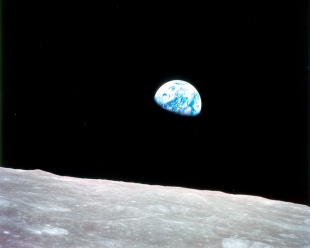I remember laying on the floor and looking up into the blue glow of the small television screen. It was the late 60s and this flickering screen created an instant and visceral connection to locations all over the real and imaginary world. It was a kind of spooky action at a distance, an entanglement with events halfway across town and halfway across the world.
People criticized Marshall McLuhan for saying that television was a two-way medium, but as a viewer it was clear that the thoughts, feelings and actions of the audience exerted a strong influence on the material flowing out of the tube. The worlds opened up by this medium seemed to be infinite, and then without warning—a parent walks into the room and flicks off the switch—the sounds and visions vanish. “Go out and play. Get out of the house.”
Imagination dead, imagine.
Samuel Beckett
In the endless arguments between so-called open and closed platforms within the Network of Networks, the charge is often hurled that such-and-such a closed platform is killing the internet. The internet by its nature is thought to be an open platform—although it’s apparently closed to closed platforms. If the open Network of Networks fills up with closed networks, then we won’t have unfettered access to any node at any time. Although it can be argued that only Google has access to all nodes, everyone else must ask Google for directions on how to get from here to there.
When we engage in this kind of talk about ‘killing the internet,’ it’s really a matter of whether the Network is more the way we like it or less the way we like it. No one imagines that the internet could actually be killed. Despite the volume and passion of the argument, no networks are ever harmed in the production of the discussion. I’m always amused by the kind of maniacal laughter engendered in the geek community by any suggestion that the Internet could be switched off. Bring up Senator Lieberman’s proposal for an internet kill switch in the company of geeks and check the response.
Imagine their surprise when Egypt recently switched off their sub-network within the internet in response to riots in the streets. I understand that Jordan and Syria also had their fingers on the switch. Tunisia’s government couldn’t withstand the protests organized via the real-time network and the army may have put the switch out of reach.
One of the lessons of Tunisia was how to use the real-time network to organize protests. The other was to shut down the real-time network if you want to disrupt the protesters. Both lessons were put to use in Egypt. There’s an assumption that the Network of Networks is so deeply intertwingled with every aspect of our lives that it can no longer be shut off. It would be like depriving a fish of water. Certainly lots of business is conducted over the internet, but in a time of national emergency, revolution and general tumult, are there geeks in Cairo upset because they can’t use FourSquare to check-in to the latest demonstration or download the Anarchist’s Cookbook to their Kindle? Anything that’s really important will be transmitted over a private network. In a Network shutdown, both sides aren’t equally in the dark.
John Perry Barlow asks whether, in light of what has happened in Egypt whether access to the Network should be considered a basic human right. Faced with an unacceptable government, the Network is an indispensable tool to foment change. It should be noted that the Network is neutral with regard to the messages it carries. A fascist uprising would benefit as much as any through the use of the real-time network.
Real-time networks work as accelerants, they contribute to the general speed up. They currently have no tools for slowing things down, correcting errors or stopping things. This makes them an excellent tool for expressing general feelings of opposition and a less than optimal tool for building new institutions to replace the old. Newspapers and magazines seem capable of both kinds of action. Perhaps this is why a free press can never be fully replaced with a real-time stream.
The moral dilemma of the open network is that it must preserve the possibility of evil.
The lessons for citizens are pretty clear, but what of the lessons for governments watching all this unfold? An internet kill switch backed by a robust private network for select services sounds like a start. Another lesson might be that the kill switch should be used sooner rather than later. Of course, avoiding situations of general revolution by fostering a healthy and happy citizenry is highly recommended. But as you look around the world, there are a large number of countries thinking about how they might implement a kill switch. Some, China, for instance, may already have such a switch in place.
As we work through this thought experiment, a number of connected issues arise. In the era of the always on and accessible broadband internet, cloud-based applications and storage seem like a rational choice. If large sub-networks of the internet can be switched off, the cloud no longer works as a global solution. If segments could be switched off within a single country, it may not be a national solution. In fact, the cloud requires a certain level of political stability to be viable in any sense. Where sometimes we might consider these kingdoms of the cloud to be challengers to the laws and boundaries of nation states, here the cloud shows that it has critical dependancies on political stability.
Synchronization, local applications and file storage show themselves to have a new value in light of the possibility of the Network being switched off. Technologies like iTunes, Evernote, Microsoft’s Mesh and Dave Winer’s approach to syncing and upstreaming local files to networked locations gain new purchase. The idea of keeping everything in the cloud now has interesting political ramifications, whereas the local master file carries some new weight.
There are two approaches to a sub-network shutdown. One is the creation of an on/off switch. Presumably once things have settled down, the plan would be to switch the Network back on. Then there’s the permanent off-switch, the switch that simply destroys the capacity altogether. An on/off switch is an expensive proposition, and of course it may be very difficult to get a majority of people to agree to it. The permanent off-switch has the flaw that it’s impossible to test. If it works, then it’s game over.
The permanent off-switch is the cousin of the doomsday machine in Stanley Kubrick’s Dr. Strangelove. Imagine a scenario where a country is under cyber-attack, rather than have their systems destroyed, they may choose to simply switch off their network. The doomsday machine would be the other defensive approach. A country lets it be known that if it is the subject of a cyber-attack it will destroy the entire Network. This would be an interesting test of the myth that the Network is robust enough to survive any such attack.
Clearly some countries could survive the end of the Network better than others, and so could more easily employ the strategy. One could imagine a terrorist group based on the theories of the UnaBomber deciding to attempt such an action. Daniel Suarez, in his book, Daemon, imagined this kind of scenario using botnets.
The seams in the Network of Networks are beginning to show as the vast differences in people, cultures, power and politics play out around the world. These differences may signal an end to the integrated synthetic Network of Networks—the Network you were given, not the one you made. It may also be an entirely unexpected way that location, or rather place, will affect your experience of the new splintered Network. Putting Humpty Dumpty back together again is going to be a wickedly difficult negotiation.
Humpty Dumpty
Aimee Mann
Say you were split, you were split in fragments
And none of the pieces would talk to you
Wouldn’t you want to be who you had been
Well baby I want that too
So better take the keys and drive forever
Staying won’t put these futures back together
All the perfect drugs and superheros
Wouldn’t be enough to bring me up to zero
Baby, I bet you’ve been more than patience
Saying it’s not a catastrophe
But I’m not the girl you once put your faith in
Just someone who looks like me
So better take the keys and drive forever
Staying won’t put these futures back together
All the perfect drugs and superheros
Wouldn’t be enough to bring me up to zero
So get out while you can
Get out while you can
Baby I’m pouring quick sand
And sinking is all I have planned
So better just go
Oh, better take the keys and drive forever
Staying won’t put these futures back together
All the perfect drugs and superheros
Wouldn’t be enough to bring me up to zero
All the king’s horses and all the king’s men
Couldn’t put baby together again
All the king’s horses and all the king’s men
Couldn’t put baby together againикони









